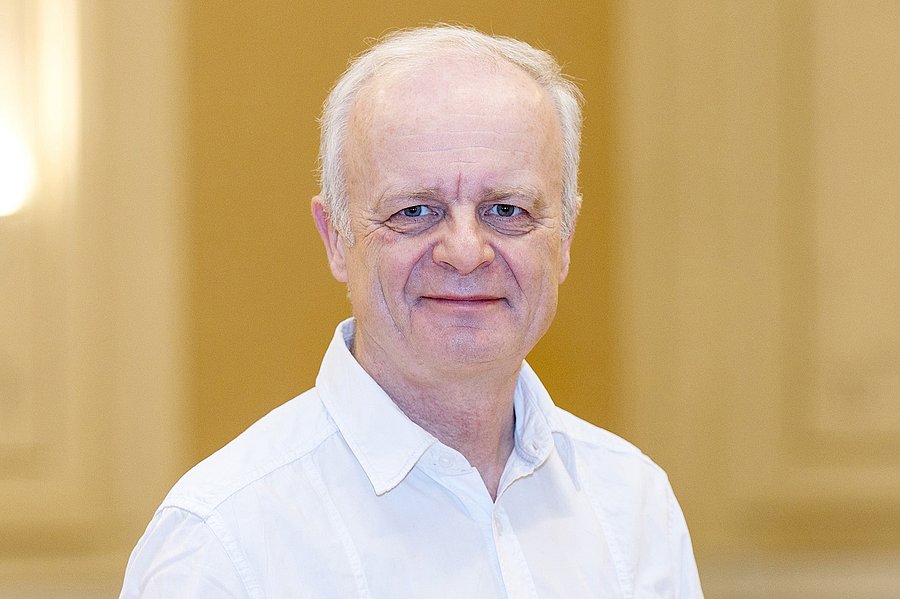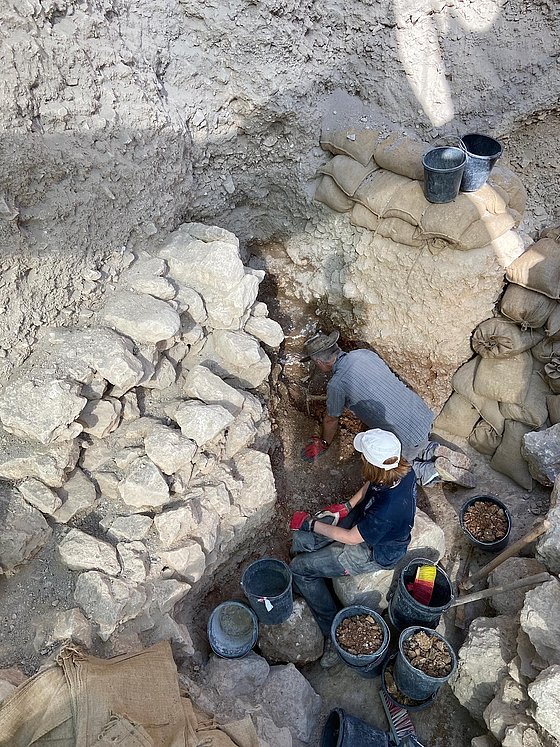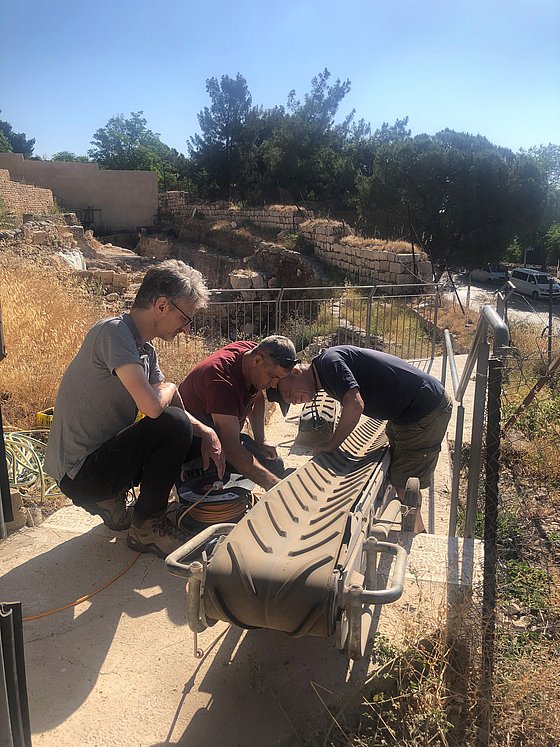
Prof. Dr. Dr.h.c. Dieter Vieweger / Biblical-Archaeological Institute
Photo: Sebastian Jarych
About the exciting discovery of a city and its walls
With his excavations, the director of the Biblical-Archaeological Institute at the University of Wuppertal, Prof. Dr. Dr. h.c. Dieter Vieweger, revises the previously assumed size of the city of Jerusalem in Old Testament.
The director of the Biblical Archaeological Institute at the University of Wuppertal, Prof. Dr. Dr. Dr. h.c. Dieter Vieweger, spends seven months a year in Israel's metropolis Jerusalem. This year, back in Wuppertal, he reports on a spectacular find that significantly changes global research knowledge about the Holy City. "We have been working in the Old City of Jerusalem for many years. However, you have to know, that the touristic Old City is the medieval Jerusalem. The Bronze Age (1800 B.C.) and Iron Age (= Old Testament; 1000-586 B.C.) Old City lies south of this city - and is hidden deep in the earth."
He said, throughout history, Jerusalem has shifted northward. This is good for today's archaeologists when looking for the ancient settlements. Thus, there are no modern houses in the way of the excavations.
"We also pursued a project in the middle of today's Old City between 2009 and 2012. We searched for the former "New City" and the wall of Herod the Great, who is described to us in detail in the historical works of Flavius Josephus and which is premised in the New Testament. We were able to dig down the huge area under the nave of the Evangelical Church of the Redeemer, 14 meters deep. Thereby we could clarify the city history of today's Christian and Arab neighborhoods, including Mount Golgotha and the question of how the Via Dolorosa ran. The whole area can still be visited in an archaeological underground park, via bridges and stairs. Before Corona, about 40,000 visitors have visited this excavation annually. However, Herod's city wall itself, built between 21 and 4 BC, was not under the church. So we had to look for other methods to find it."
Pedology in a night action
During the last five years, Vieweger repeatedly set out with a team from the Ilmenau Technical University and a wood/carbon vehicle in the middle of the night. They combed through the then tourist-free city to take a look underground, about 20 meters, with a special kind of georadar. This actually provided evidence of two wall sections that belonged together and clarified the size of the Herodian city at the end of the first century BC.
"Additionally, we shifted our excavation focus to Mount Zion, the original Old City south of today's Old City. Our question was in what time people lived here from the Iron Age (?) on up to the Islamic era. What social class lived here at the southern access to the city? What crafts were they engaged in, how comfortable were their hats, etc.? Overall, it was still unclear when the city of Jerusalem actually extended to the most southern point of urban settlement we excavated (before breaking off into the Hinnom Valley)." The Herodian and Byzantine city walls had been found there already a long time ago, including the corresponding city gates. "But where was the wall of the Iron Age (of the Old Testament)? In the northern part, so to speak at the other end of the city, this Old Testament city wall was proved several times. There, in the Jewish quarter, tourists can marvel at the six-meter-thick wall, which was once between eight and ten meters high. A second piece of the wall has been discovered in the so-called David's Citadel (which has nothing to do with David!)." Yet the history of this Old Testament city is already special. In the 8th century BC, at the time of Kings Ahaz and Hezekiah, all the states of the southern levant were challenged. And in the end, not a single kingdom survived, Vieweger explains. The army of the huge empire of the Assyrians was "at the door" and prepared to conquer the entire territory and ultimately even lower and upper Egypt! "The Assyrians had already destroyed the Northern Kingdom of Israel and simply led away the upper class. During their 200 years of rule over the then known world, they deported approximately 2.6 million people. After all, the Old Testament tells us about this. And Israelites who did not want to be captured fled south, to Judah, because they spoke the same language, had the same faith, and knew the city of Jerusalem." To safely protect these crowds, the city had to expand and was given a new city wall.
One must keep in mind where walls were built in the first place and how a people could protect itself against potential enemies by doing so. "After all, the enemy is supposed to cut his teeth," Vieweger says, "and so the walls must always be built cleverly against the hills, in order to leave the enemy no possibility of attack or deployment." So the question is always: where on the edges of the valleys surrounding Jerusalem would you build a wall? And how many refugees had escaped from Israel in the 8th century? How large would the newly walled city have to be?

Doubts on the long-held wall thesis
A find by the Benedictine monk Bargil Pixner, which he made in the 1980s and dated to the Iron Age, was regarded as an established fact of the maximum extent of the Iron Age wall course in the south for a long time. However, the site was not investigated in its entirety, but was partially filled in again after the excavation ended in 1988. The area fell into disrepair, became overgrown and was used as a garbage dump. When Vieweger resumed excavations at this site, the team soon had doubts about Pixner's thesis, because "throughout our years of excavation, we made the same observations that our Israeli colleagues had made a little further east. We did find a few Iron Age shards everywhere, which could also have come from shepherds or been washed down with time," he explains, "but we never discovered an Old Testament house. Was there no Iron Age city at all on this large scale (as it was thought to be)? After all, was it ultimately much smaller and did far fewer refugees from the northern kingdom of Israel come to Jerusalem?"
Walls are difficult to date. Stones are placed in the ground, but there is always a foundation trench, a shaft, in which you put the base of the wall. The pottery shards found there reveal the earliest date when the wall could have been built. The shards are always older than the construction work. To remove all doubts, Vieweger decided to continue digging at Pixner's wall find in 2020 (the corona year), without his other team of about 40 volunteers. With a small team of just 12 people, Vieweger set out in early summer. "We removed this layer of rubble, which was up to 7 meters high and about 12 to 14 square meters in circumference, by hand. We had been given three conveyor belts, from our circle of friends in Wuppertal, with which we transported the material to the top. And then we could explore all the areas where walls could have been built, to the depth of their foundation trenches." This was an exhausting task, and one in which the 62-year-old naturally lent a hand. To be able to correctly date the wall, Vieweger used three methods. "We took the ceramics from all the walls in the foundation trench for dating. We also used what is known as C14 dating for the organic materials, and finally we used thermoluminescence dating, or OSL for short." In OSL dating, Vieweger explains, one takes soil that has not been exposed to light since it was built and examines when that soil was last exposed (i.e., exactly when the wall was placed on that soil). During the long time the earth magnetism charges the electrons of the earth year by year. And this "charging" can be measured and, from it, at least the century in which the earth was last exposed to light can be determined. "We used the three different methods because we wanted to be sure that our time determinations are correct!

Casemate wall disproves previous assumption
"Here, the result was completely surprising. We did not find a continuous, thick wall of the Iron Age as we know it further north. The Old Testament city did not extend to this southern point to break off into the Hinnom Valley. It was definitely smaller. Four different walls were found: from Hellenistic, Hasmonean, Herodian and Byzantine times. The wall determined by Bargil Pixner to be of the Iron Age, was a casemate wall. This means, it was an inner wall and a parallel outer wall, with transverse walls between them, always built in at right angles. In the case of peace, one could use these interstices as a place to store tools or weapons. In the case of war, the voids were poured full with earth; and when the enemy thrusted into them, they compacted the wall even more." Interesting is that 100 years ago, two American archaeologists, Frederick Jones Bliss and Archibald Dickie, had already found a casemate wall built in exactly the same way just 300 meters away. But they did not know how to classify it. Vieweger, who also gets visitors at his excavation sites, was reminded of this by his Israeli colleagues. "And so we found a continuation with exactly the same dimensions of the inner wall and the outer wall and the spaces in between. Through the found pottery, it was clear that the wall was built in the third or second century B.C."
Vieweger was able to view the records of Bliss and Dickie in the Palestine Exploration Fund. "In 1896, accurate details were given by both in beautiful drawings true to scale that could be measured." Thus Bargil Pixner's dream of finding the great Old Testament city, died there for the first time.
Where was the wall really? - A mind game with logic and luck
But this by no means answers Vieweger's questions. Where was the Iron Age wall really located, of which we have known the northern wall features for a long time? "Further down the slope is not possible, it is too steep and deep. The wall would have slided down and would not be defensible. We have to look further north. The flat areas are unsuitable for walls. Only there, where the terrain rises again, one would build a city wall again. We are not allowed to dig in many places because they are considered 'occupied territory' under international law. But further up on Mount Zion near the Catholic Dormitio Abbey, there would be a chance." This is where the researcher will start again in the coming year. He has already started talks with the abbot there to possibly be allowed to dig in the monastery garden.
An archaeological course of study in Bethlehem
The bustling scientist always has plans. He plans to establish a new archaeology course at the Catholic University in Bethlehem. "The DAAD has approved a long-term lectureship. The peopleto be selected, will then work at the university for six years each. Thereby, we can establish a small degree program in the Faculty of Tourism with an archaeologist who is already working in Bethlehem and whom we know well, as well as this new staff member. My goal is to work with these two people, so that the students can explore their own history in and around Bethlehem." To this end, he is also looking for a suitable, manageable excavation site that the students can excavate, make accessible to tourists, and subsequently maintain on an ongoing basis. Vieweger is thinking in terms of exemplary learning and emphasizes that such thinking is not very common in the Arab world. "Archaeological sites are not sites where money can be taken. All the entrance fees will never outweigh the amount of cleaning, securing and repair work. An excavation site will always remain in deficit. A company can only win if everyone works together. Bus, hotel, room service, guides, etc. The cities and areas must allocate their profits so that the person who sits at the gate of the excavation site and is responsible for the signage as well as the routing can also earn a living." For Vieweger, this is practical help for self-help, which he is happy to pass on to future generations based on his many years of experience.
Uwe Blass (Interview on December 4, 2020)
Prof. Dr. Dr. h.c.. Dieter Vieweger is Professor of Old Testament and Biblical Archaeology at the Kirchliche Hochschule Wuppertal/Bethel, Visiting Professor of Archaeology at the Private University of Witten-Herdecke, Executive Director of the two institutes of the German Protestant Institute for Ancient Studies of the Holy Land in Jerusalem and Amman, representative of the Provost in Jerusalem and coordinator of Protestant educational work in the Holy City, and Director of the Biblical Archaeological Institute at the University of Wuppertal.
